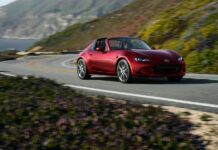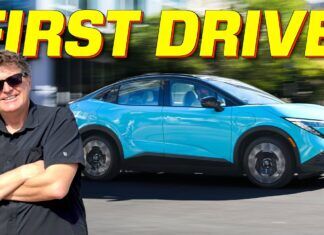Following the Camry’s redesign, it’s luxury counterpart gets an even more ambitious overhaul.
It may not sell gangbusters like the Toyota Camry, but the Lexus ES is still a core pillar of the luxury brand’s portfolio. Trouble is, it’s been more than six years since the current model went into production, so it’s desperately needed a major update. Fortunately it’s finally getting one, as Lexus revealed the 2026 model year ES at the Shanghai Auto Show Wednesday.
Like its mainstream sibling, the 2026 Lexus ES rides on Toyota’s GA-K platform and features the familiar 2.5-liter-backed hybrid powertrain, at least on the base trim. The major difference arriving with this eighth-generation model, however, is a couple of fully electric powertrains as Lexus expands EV offerings beyond the existing RZ crossover.
In its evolution, the 2026 Lexus ES range drops the more curvaceous styling of past Lexuses (Lex-ii?) for the edgier look of the RZ, and indeed the brand’s other recent revamps like the TX and RX SUVs. It loses its large spindle grille in the process, though the shape of the front end still tracks with what we’ve associated with Lexus models over the past several years. It’s just that now it’s more of a facade with contrasting trim elements and creases to signify the look, rather than actual grille trim (though the lower grille is still there for cooling). Other Lexus hallmarks like the check-mark running lights are still there, while the ES’ rear end adopts a much more aggressive look, including a thin LED taillight and full-width bar incorporating the “LEXUS” font in the light signature.
The hybrid ES gets a bit more oomph and will be available in FWD and AWD configurations
On the gas-hybrid side, the 2026 Lexus ES 350h replaces the 300h, while all gas-only models are gone (again, like the updated Toyota Camry). You still get a 2.5-liter four-cylinder engine, though this time it’s paired with an integrated “eAxle” combining the power control unit and transaxle for a smaller and lighter package. You get a bit more power this time around, up to 244 horsepower from 215 in the last generation. It’s still focused toward efficiency over performance, mind you, so Lexus’ acceleration quotes aren’t blistering for either hybrid model: 0-60 comes up in just under 8 seconds with the front-wheel drive version, and a couple tenths of a second quicker than that if you get the all-wheel drive ES 350h.
If you’re able, ready and willing to leave internal combustion behind entirely, then there are two electric ES options available. The base version is the ES 350e. This model incorporates just one 221 horsepower electric motor driving the front wheels, for a 0-62 mph time of 8.9 seconds. The dual-motor, all-wheel drive ES 500e, on the other hand, manages 338 horsepower, bringing the 0-62 time down to 5.9 seconds. That’s better, though still not anywhere near blazingly fast, particularly in today’s EV landscape.
Lexus did not share battery capacity for either of its electric models. However, it did say to expect about 300 miles on a charge for the ES 350e, when equipped with 19-inch wheels. Other sedans in the same sort of size class use a battery capacity around 75-80 kWh to achieve that kind of range, though that’s purely spitballing as the efficiency of the electric motors, the battery chemistry, weight and quite a few other factors can impact the actual EPA estimates.
The 2026 Lexus ES gets a minimalistic interior
Stepping inside the new ES, the interior isn’t exactly what you’d call flamboyant, though there are a few nice touches such as the bamboo-themed 3D-printed door trim with underlying ambient lighting. Naturally, you also get a larger 14-inch infotainment screen and a 12.3-inch digital instrument cluster. Features like wireless Apple CarPlay and Android Auto as well as a Mark Levinson premium sound system, and an updated, more responsive voice assistant. Lexus also incorporated navigation and map functionality into the gauge cluster, so you don’t have to glance over at the main screen for directions.
As part of its tech overhaul, the new ES brings in Lexus Safety System+ 4.0, which iterates on the wide range of driver assistance features we see in the current systems. Lexus didn’t elaborate on exactly what changes are coming to 4.0 over the 3.5 version, apart from saying it “will have updates to its hardware and detection capabilities”, and that we’d get more details closer to launch.
Overall, the 2026 Lexus ES lineup is 6.5 inches longer than before, riding on a 3-inch longer wheelbase. So, this generation will be a bit roomier than before, while the automaker says its raised the seats to make entry and exit easier and improve sight lines. From personal experience that’s a welcome change, because getting into the old ES more or less meant falling into the seats.
Speaking of those seats, Lexus is offering an “Executive Package” on North American ES models for the first time, provided you go for the Luxury trim. That includes reclining rear seats with a passenger-side ottoman, rear outboard massaging seats and heating/ventilating functions for the rear passengers as well.
Pricing information for the 2026 Lexus ES lineup isn’t available yet, and it’s a bit difficult to guess considering the entire lineup is pretty much moving a notch upmarket. The old ES 250 and ES 350 models are out, as is the ES 300h, so pricing for the 2026 ES 350h will probably land closer to the $50,000 mark. We’ll almost certainly see the EVs land at higher price points still, as rivals like the BMW i5 and Audi A6 e-tron both start in the upper-$60,000s.
The eighth-generation 2026 Lexus ES will officially go on sale next year.
























